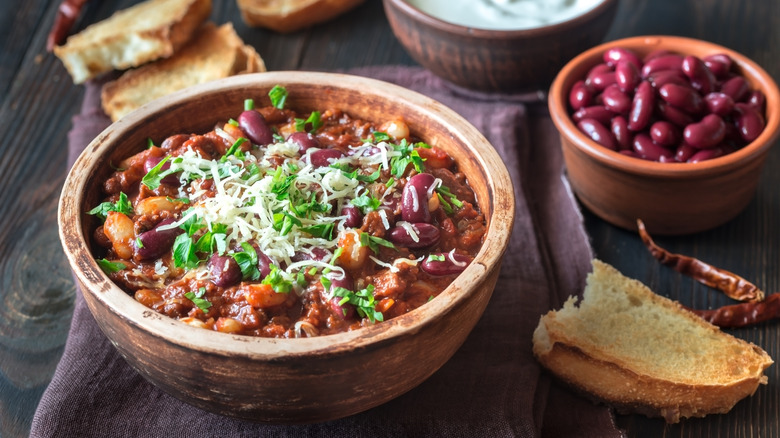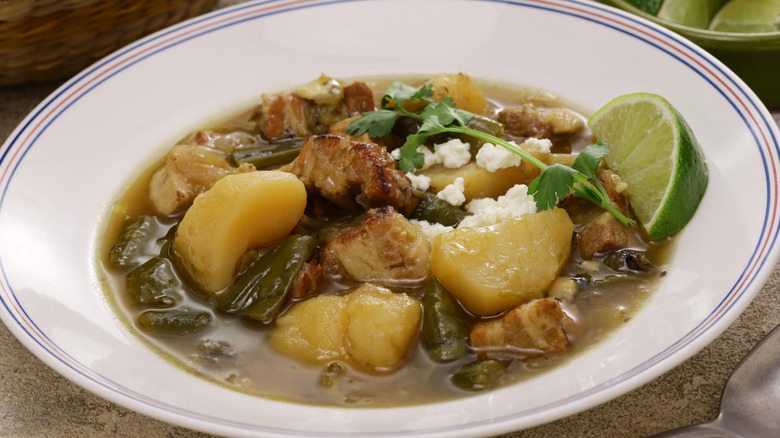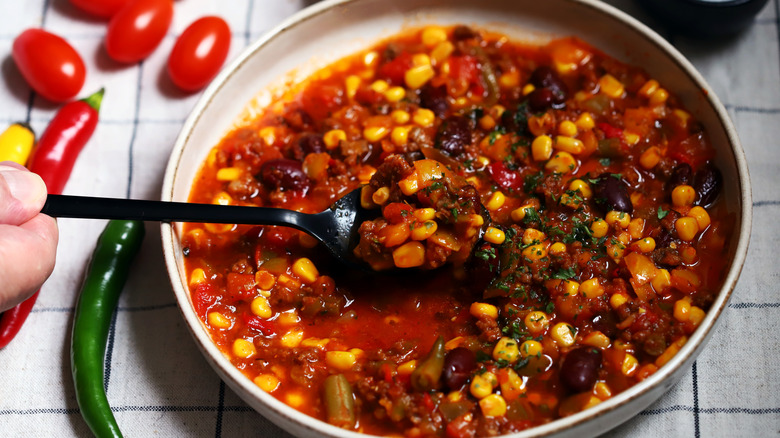Here's The Difference Between Green And Red Chili
With so many different variations of chili out there, it can sometimes feel like a struggle to pick one to make. While relying on your favorite canned chili brand is easy in a pinch, it's often better to spice up (no pun intended) your night with a homemade meal. If you're looking for recipes, you'll probably stumble upon both chili verde and chili con carne — or green and red chili — but what separates the two? To find out, Food Republic spoke with Joanne and Adam Gallagher, recipe creators and founders of Inspired Taste.
"Chili con carne stands out for its bold beef and smoky red chile flavor," they explained. "Chili verde is all about tangy, green flavors and a stew-like texture." The main difference between chili con carne and chili verde lies in the type of chile pepper used as the base, which greatly influences the overall flavor and color of each dish. Chili verde, as the name suggests, uses green chiles, whereas chili con carne opts for red chiles. These are the same type of pepper — the difference comes down to when they are harvested. Green chiles are picked before they reach full ripeness, giving them a fresher, slightly vegetal taste with a sharper heat. Red chiles are harvested later, when they're fully ripe, so they develop a sweeter, smokier flavor with a more intense spiciness.
What is green chili?
Chili verde is a dish deeply rooted in the history of Mexico. "It gets its bright, tangy flavor from roasted tomatillos and green chiles like jalapeños or poblano peppers," Joanne and Adam Gallagher explained. "It is usually a bit more saucy and vibrant than the thick, hearty chili con carne."
The dish's fresh, lively character comes from the abundance of green chiles, which infuse the sauce with a sharper, more pungent note as opposed to the smokier depth of dried red chiles used in other variations. The tomatillos, high in water content and acidity, create a flavorful green sauce base that results in a profile that is both lighter and more vibrant. "Sometimes there is cilantro or lime for extra freshness," the Gallaghers added. Both are classic Mexican garnishes, with cilantro providing herbal brightness and lime offering a citrusy burst that wakes up the ingredients in the dish.
"Pork is usually the main protein," the Gallaghers added. Pork can be found everywhere in Mexican cuisine, from carnitas to the Yucatán's roasted cochinita pibil. In chili verde, the preferred cut is often pork shoulder, which is prized for its tenderness and ability to absorb spices and marinades. During cooking, its high collagen breaks down into gelatin, turning the meat into succulent, pull-apart pieces and giving the sauce a deliciously silky, lip-smacking mouthfeel. Using bone-in shoulder enhances the stew even further, infusing it with marrow and collagen to add a whole new level of depth and complexity.
What is red chili?
Originating in Texas and inspired by hearty Mexican stews, chili con carne is a true Tex-Mex classic. "Chili con carne is all about beef, cooked slowly with dried red chiles, cumin, and oregano," Joanne and Adam Gallagher told us. The slow cooking process allows all those ingredients to properly come together, resulting in "a rich, savory, smoky, meaty flavor."
Beef became the natural choice for chili con carne as several tougher (and more accessible) cuts like brisket, chuck, or short ribs contain plenty of fat and connective tissue. These break down during the low-and-slow simmering process, resulting in tender meat and a deep, robust flavor that holds its own against other bold ingredients such as dried red chile pods, tomato paste, and kidney beans (balsamic vinegar also works great to give homemade chili some tang), whereas milder meats like pork and chicken might be overpowered.
The cooking process itself is what truly sets chili con carne apart. It relies on long, slow simmering to allow the flavors of the beef and chiles to meld and the sauce to thicken. Traditional varieties will forgo fresh chiles in favor of dried ones like ancho or guajillo for deeper, smokier flavors that thicken the stew as they rehydrate. As the ingredients reduce, the "bold beef and smoky red chile flavor" begins to develop, as the Gallaghers explained. It's best enjoyed with rice or cornbread, both perfect for soaking up every bit of that flavorful sauce.



